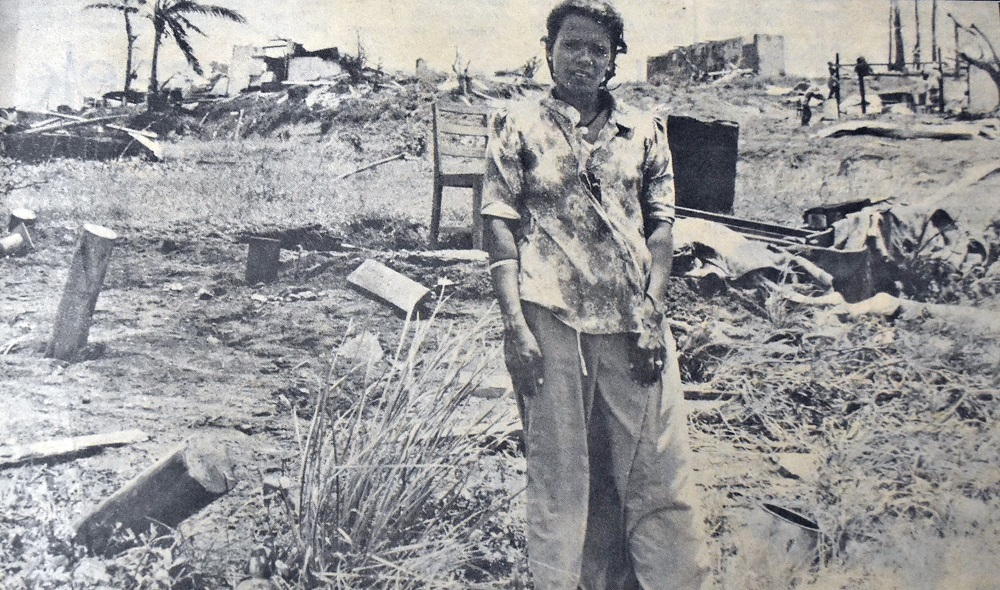Looking back over the past decades, cyclones and hurricanes have become a way of life for Fiji.
From mid-November to mid-April, it has become the norm that a storm could be headed our way, and people expect and prepare for this every year.
In an article published in The Fiji Times on January 19, 1985, it was reported that despite the numerous natural disasters that have struck Fiji, people still seemed to take lightly the impact and effects that cyclones had on our lives.
The article was published to remind citizens of Fiji of the suffering and socio-economic disaster they brought to the country.
The news piece said every year, the destruction and death toll from the cyclones continued to mount higher and higher, but yet Fijians would look ruefully at the devastation and carriage in the wake of the cyclone and say “I did not think it would be so bad”.
Cyclones are extremely unpredictable phenomena – they vary in strength as they go along and can change direction without much notice. They can fizzle out or increase within a matter of hours and can destroy in less than an hour what it takes men many years of painful labour and sweat to produce.
In laymen’s terms, a cyclone develops as a small low-pressure centre in an area of intense heat.
What makes the low-pressure centre develop into a mass of fury that tears, lashes and whips at everything in its path, is not easy to understand. What we do see is a terrifying picture of winds blowing at 200km per hour, lashing out at objects in its path.
Man, with all his technological achievements, his artificial heart transplants and outer space adventures, is still no match for the unleashed fury of mother nature.
All we can do is barricade ourselves in our homes and hope that the cyclone passes us by.
In past years, around the last one to two decades, it appeared as if cyclones have increased in numbers and in their intensity, if the damage they wreck was anything to go by.
Whether it was true or not, statistics showed that since 1970, at least 29 cyclones and hurricanes had hit us. Some had merely passed close by Fiji, bringing increased rain and winds to the island and causing minor damage.
Others have carved a niche for themselves in Fiji’s memory, causing millions of dollars’ worth of damage, leaving thousands homeless causing havoc, misery and death.
Hurricane Bebe in 1972, with wind speeds of between 120-130mph took 20 lives, and made about 3000 homeless, left 50,000 under the government relief distribution scheme and caused damage estimated at $20 million.
This brought the Prime Minister’s hurricane relief fund along with the setting up of a special program known as the Emergency Services Committee (EMSEC) which was activated as soon as fears of a natural disaster were aroused.
Cyclone Meli in March 1979, was another “mighty” one that took 45 lives, and made 5000 homeless on Kadavu and 300 in central Lau.
Cyclone Oscar in 1983 was a major economic disaster which caused more than $100 million damage to homes, hotels, buildings, sugar cane fields, and vegetation and crippled Fiji’s tourism sector for months on end.
In 1970, Fiji was visited by two minor cyclones, Claire and Dolly.
In 1971 Thelma appeared in March and Ursula in December. In 1972, Wendy passed close to Fiji in February, but didn’t strike the country. But later that year, enormous damage were caused by Bebe at the end of October.
In 1973, we had Juliette which mainly affected northern Vanua Levu in April while December that year started off with cyclone Lottie causing trouble in the Lau Group.
This resulted in the Uluilakeba disaster where 79 passengers were missing when the ship capsized in stormy seas in Lau.
The following year, 1974, appeared to have been a year of respite, as was the year 1984.
But in 1975, Val with wind speeds of between 110-170 knots, hit Lau while Cyclone Betty caused some damage to Vatulele through a tidal wave.
The year 1977 was a year of cyclones, where four had visited the country.
Marian arrived in January and affected mainly the Yasawas, Kadavu and the Lau Group.
Then there was Norman, Steve and Anne who visited in November and December. The next year, 1978, we had three cyclones … Bob in January, Ernie in February and Fay in December. So at this point, one can already fathom the destruction, deaths, misery and havoc caused by cyclones over the years.
Bob was confined to the Yasawas, North and West.
Ernie caused damage to Cikobia while Fay concentrated on Eastern Vanua Levu. Early in 1979, Hendry appeared and then in March, the devastating Meli. Four cyclones struck the country in 1980; Cyclone Peni wiped the north-eastern parts of Fiji in January while Cyclone Rae passed close to Fiji in February.
Tia, with wind speeds of 50-60 knots, hit northern Vanua Levu at the end of March. And close on its heels came Cyclone Wally in early April causing widespread flooding and landslides spoiling many Easter games that year.
It claimed 13 lives. These were some of the devastating cyclones in the past that had shaken our country to the core. Therefore, it is important to always be prepared and to not underestimate any natural disaster, but to learn from it.

